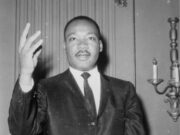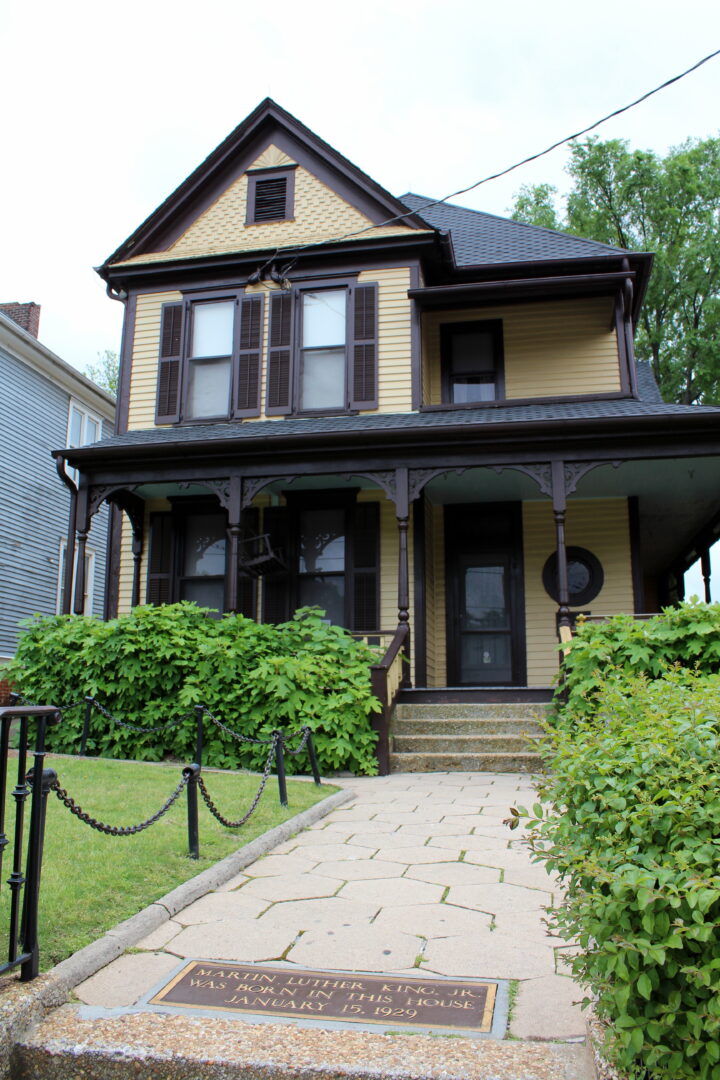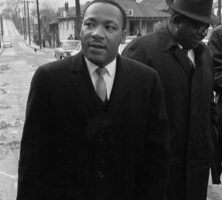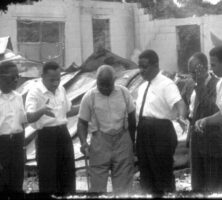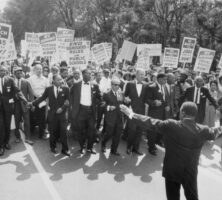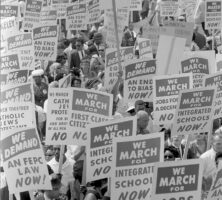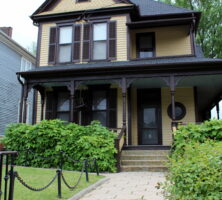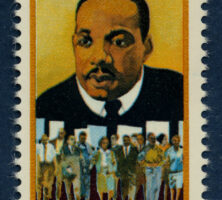Martin Luther King Jr., a Baptist minister and president of the Southern Christian Leadership Conference (SCLC), was the most prominent African American leader in the civil rights movement of the 1950s and 1960s.
Early Life and Education, 1929-1955
Family, church, and education shaped King’s life from an early age. He was born Michael Luther King Jr. in Atlanta on January 15, 1929, to Alberta Williams and Michael Luther King Sr. In 1934, after visiting Europe, Michael King Sr. changed his and his son’s name in honor of the sixteenth-century German church reformer Martin Luther. King spent his early years in the family home at 501 Auburn Avenue, about a block from Ebenezer Baptist Church. His maternal grandfather, A. D. Williams, was pastor at Ebenezer from 1894 until 1931. After Williams’s death, the elder King succeeded his father-in-law at the pulpit.
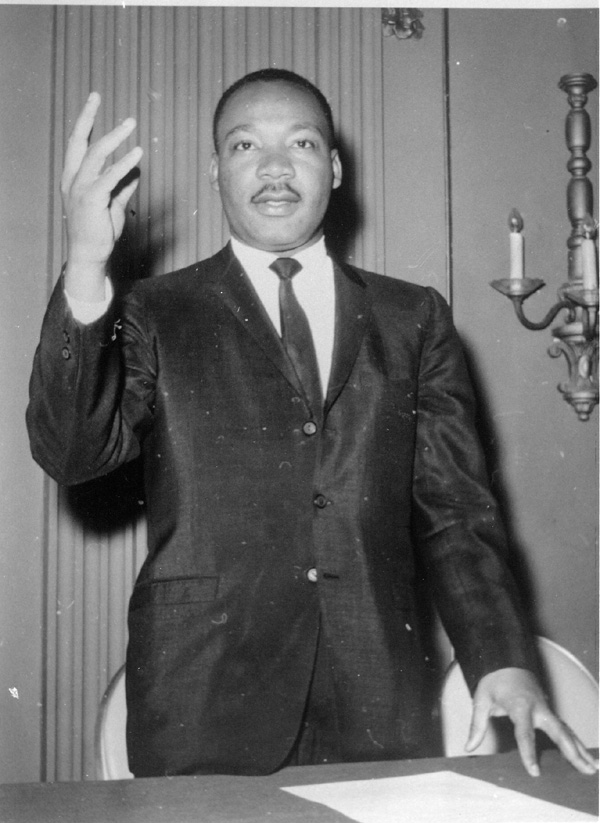
King was educated in Atlanta, graduating from Booker T. Washington High School in 1944. He then enrolled at Morehouse College, where Williams had studied. King first considered studying medicine or law but decided to major in sociology. He ultimately found the call to the ministry irresistible, however. He served as assistant to his father at Ebenezer while studying at Morehouse. In February 1948 King Sr. ordained his son as a Baptist minister.
After graduating from Morehouse in June 1948, King studied for a divinity degree at Crozer Theological Seminary in Upland, Pennsylvania, and graduated in May 1951. The following September King enrolled in the Ph.D. program in systematic theology at Boston University. There he met his future wife, Coretta Scott. King’s father preferred that his son marry an Atlanta woman and initially opposed King’s plans to marry Coretta. When King refused to back down, his father relented, and on June 18, 1953, he performed the marriage ceremony at the Scott family home in rural Perry County, Alabama.
During his last year of residential studies at Boston University, King sought employment while he finished his dissertation. Through a family friend he learned of a vacant position at Dexter Avenue Baptist Church in Montgomery, Alabama. King desired a pulpit in a southern city but also wanted to escape Atlanta and gain independence from his father, so he arranged a trial sermon. King was offered the position, and in 1954 he moved to Montgomery with Coretta. In June 1955 King received his Ph.D. The Kings’ first child, Yolanda Denise, was born November 17, 1955.
King and Civil Rights, 1955-1960
On December 1, 1955, Rosa Parks, a respected member of Montgomery’s Black community, refused to surrender her bus seat to a white passenger when asked to do so. She was arrested for violating a city segregation statute. Community activists proposed a bus boycott in protest. They asked King if his church could be used as a meeting place to discuss the boycott. Although he supported the plan to boycott, King hesitated to become involved because of his existing commitments. After some persuasion, however, he agreed.
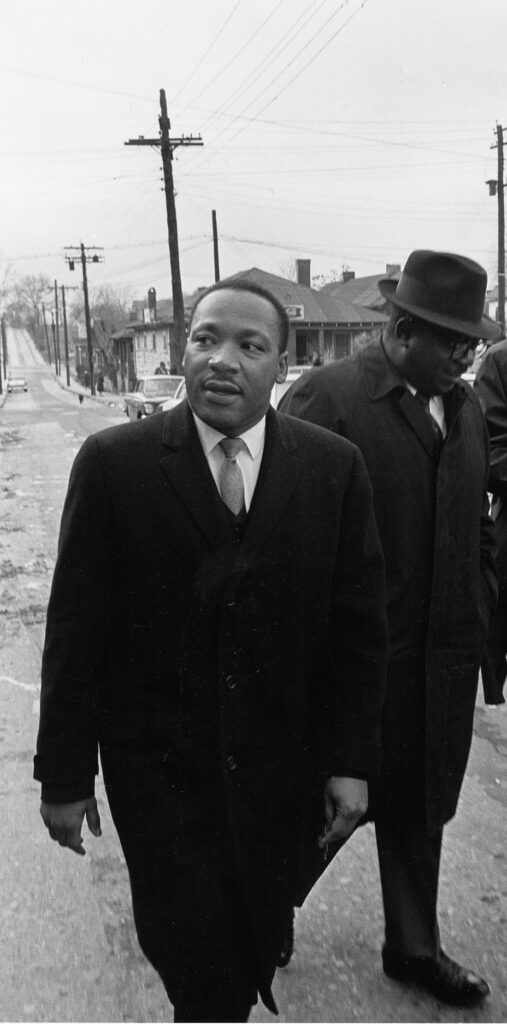
At the meeting Black leaders agreed on a one-day boycott. When this was successful, they agreed to extend the action. King was asked to head the Montgomery Improvement Association (MIA), a new organization formed to run the bus boycott. He had not planned to take a leading role, but he agreed to serve. The boycott ran for 381 days. Throughout, whites in Montgomery tried to stymie it. King and other MIA members were arrested. Segregationists even bombed King’s home.
The intimidation strengthened the resolve of the Black community. The initial demands of the MIA for a modified system of segregation on city buses evolved into a lawsuit that called for its total abolishment. The case went all the way to the U.S. Supreme Court, which ruled segregation on Montgomery buses unconstitutional. On December 21, 1956, King was among the first passengers to board an integrated bus.
The bus boycott made King a national symbol of Black protest. In the next few years he spoke alongside other national Black leaders and met with U.S. president Dwight D. Eisenhower and a host of foreign dignitaries. In 1958 King published Stride toward Freedom, his account of the Montgomery boycott. His newfound recognition came at a price. In September 1958 a mentally ill Black woman, Izola Ware Curry, stabbed King in the chest at a book signing in New York. King barely survived the injury. Earlier that month, police in Montgomery had again arrested King. The Federal Bureau of Investigation (FBI) began to take an interest in him, starting a covert surveillance of his activities that continued for the rest of his life.
Despite the personal challenges King looked to capitalize on the success of the Montgomery boycott. In August 1957 the Southern Christian Leadership Conference (SCLC), an organization comprising religious, civic, and political affiliate groups, was launched with King as president. The SCLC, headquartered in Atlanta, initially focused on supporting bus boycotts and instituting drives to register Black voters. These early campaigns made little impression. At the end of 1959 King resigned from his position at Dexter and in early 1960 moved back to Atlanta, sharing the pastorate at Ebenezer with his father. There he could maintain closer contact with SCLC headquarters in the hope of launching more effective campaigns in the future. Though his work kept him away much of the time, Atlanta remained home for King, Coretta, and their children, for the final eight years of King’s life.
Nonviolent Direct Action, 1960-1963
Events quickly overtook King and the SCLC. In February 1960 four Black students staged a sit-in at a segregated lunch counter in Greensboro, North Carolina. The sit-in movement rapidly expanded to other cities, where it met with some success in persuading local communities to desegregate facilities. In April 1960 the Student Nonviolent Coordinating Committee (SNCC), based in Atlanta, was formed to support student protest. In 1961 the Chicago-based Congress of Racial Equality (CORE) held interracial “freedom rides” to test the court-ordered desegregation of southern bus terminals. The freedom rides ultimately led to federal action in upholding the court order.
The success of sit-ins and freedom rides demonstrated the relevance of nonviolent direct action to the civil rights movement. During the Montgomery boycott, two of King’s close advisors, white pacifist Glenn E. Smiley and Black activist Bayard Rustin, tutored King in nonviolence. King’s interest in nonviolent protest continued to develop and became a central tenet of his leadership. King joined student sit-ins in Atlanta, though he declined an invitation to participate in the freedom rides.
King and the SCLC embarked upon their first nonviolent direct-action campaign in 1961 in Albany, at the invitation of local Blacks. The Albany Movement encountered numerous problems. King and the SCLC lacked specific goals and a coherent strategy. Divisions in the Black community hampered demonstrations. Albany police chief Laurie Pritchett refused to engage protestors in conflict and instead made mass arrests that quickly depleted the movement’s resources. Without dramatic points of confrontation, the tactic of nonviolence lacked potency. The federal government refused to intervene, and the local white business community refused to enter into substantive negotiations. The campaign dissolved without gaining any significant concessions.
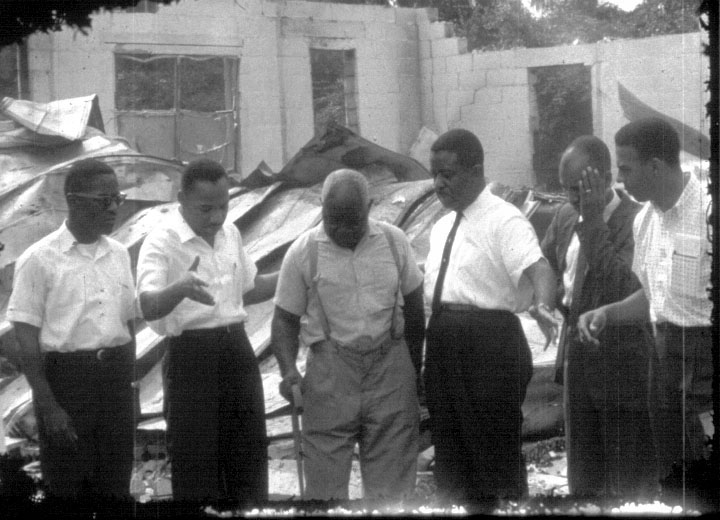
Learning from Albany, King and the SCLC carefully chose their next target in 1963. In Birmingham, the Alabama Christian Movement for Human Rights (ACMHR) under the leadership of the Reverend Fred Shuttlesworth provided an established local base for protest. Specific goals and a strategy for the movement were drawn up in advance. As expected, the Birmingham police chief Eugene “Bull” Connor met protestors with force, using police dogs and high-power fire hoses to break up demonstrations. The conflict brought national news headlines and federal intervention, and pulled local white businessmen to the negotiating table. The campaign made significant gains in desegregating downtown facilities and in opening up Black employment opportunities, although segregationist violence in the city remained a serious problem. Arrested and jailed for eight days during the Birmingham campaign, King composed his well-known “Letter from Birmingham Jail” during his incarceration.
Desegregation and Voting Rights, 1963-1965
The years between 1963 and 1965 represented the high point of King’s career. In August 1963 the civil rights movement staged its largest gathering ever, with as many as 250,000 participants at the March on Washington for Jobs and Freedom. King’s “I Have a Dream” speech was the most memorable event of the day and confirmed him as Black America’s most prominent spokesperson. In 1964 King was awarded the Nobel Peace Prize in Oslo, Norway. The same year, Congress passed the 1964 Civil Rights Act, outlawing segregation in public facilities. In 1965 King and the SCLC campaigned in Selma, Alabama, for Black voting rights. The campaign led to the passage of the 1965 Voting Rights Act, which abolished legal impediments to voting rights for African Americans and initiated greater federal protection for Blacks at the polls.
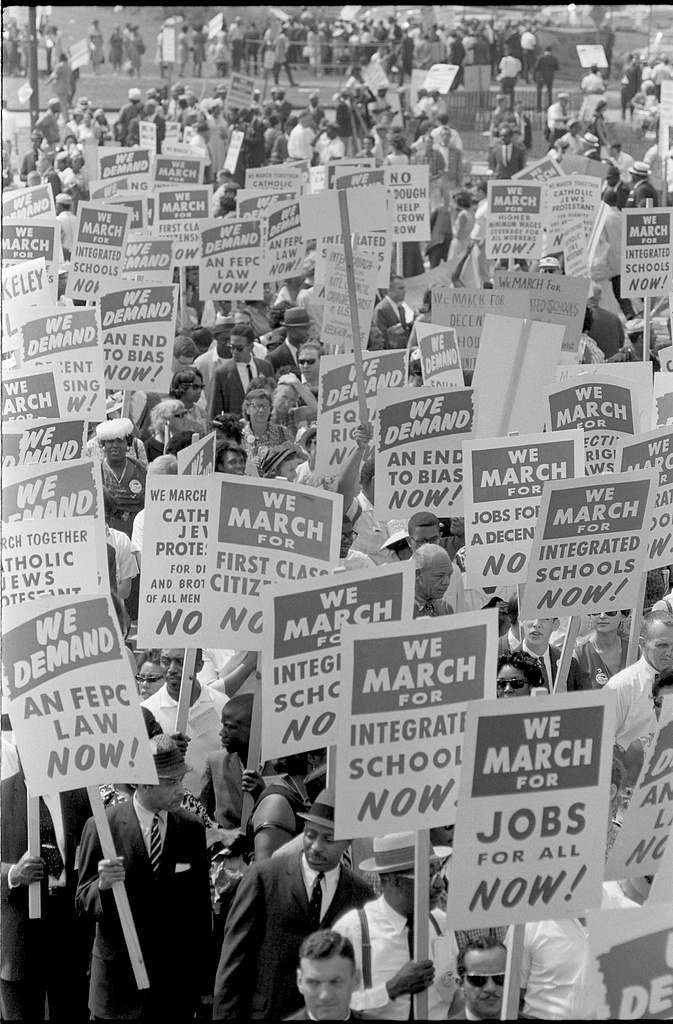
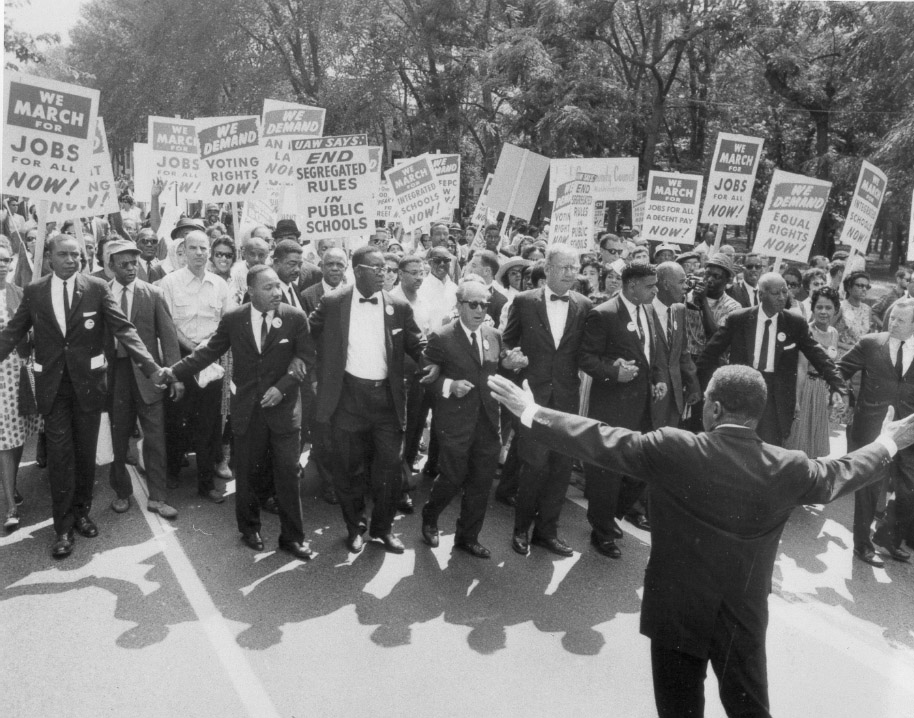
Not everything went King’s way. After a surge in white violence in Birmingham, attempts to renew demonstrations met with stiff opposition and failed to make much headway. King lost a carefully cultivated federal ally when U.S. president John F. Kennedy was assassinated in November 1963, though the new president, Lyndon B. Johnson, proved equally if not more sympathetic with the civil rights movement. The SCLC launched a new campaign in St. Augustine, Florida, in 1964, but it failed to win meaningful concessions for local Blacks. King’s attempts to mediate the seating of the Mississippi Freedom Democratic Party delegation at the 1964 Democratic Party convention failed as well. Around the same time the FBI stepped up its campaign of harassment and intimidation against King.
As was often the case in King’s relatively short public career, victory and defeat, as well as advancement and setback, were never far apart.
New Directions, 1965-1968
In the last few years of King’s life, important changes were taking place in his thinking, in the civil rights struggle, and in American society. Between 1965 and 1967 Blacks rioted in several U.S. cities. In 1966 some activists adopted the slogan “Black Power,” which represented a new wave of militancy that, frustrated with persistent racism in American society, questioned the relevance and efficacy of nonviolence in addressing racial problems. The escalation of the Vietnam War shifted public debate, material resources, and political will away from the civil rights movement. Conservative politicians, playing to a white backlash against Black gains, were increasingly successful in advocating a tougher law-and-order stance to subdue protest.
King responded to these developments in a variety of ways. He took the SCLC into the northern ghettos in an attempt to alleviate the conditions that caused the urban riots. He opposed much of the angry rhetoric of Black Power and continued to stress the importance of nonviolence. He spoke out ever more stridently in opposition to American involvement in the Vietnam War. He opposed conservative politicians who sought to exploit white racial fears. He also gained new insight about Black problems in the United States as the movement shifted from tackling segregation to confronting the problem of racial discrimination.
In 1965-66 the SCLC launched its first northern campaign in Chicago. King felt that the urban riots in northern cities underlined the need for SCLC assistance, focusing on such issues as Black employment, housing, and education opportunities. The Chicago campaign highlighted the difficulties of fighting entrenched racism. The city was much bigger than previous communities in which the SCLC had worked. Discrimination was much more difficult to dramatize than segregation. SCLC funds declined, making operations even more problematic. Despite some successes, the SCLC failed to make the desired impact on Black advancement in Chicago.
The Chicago campaign convinced King that many of the problems faced by African Americans were due to fundamental economic inequalities in American society. Consequently, he called for a redistribution of wealth and resources, advocating a move away from the harsher aspects of capitalism toward a society modeled on some form of democratic socialism. The last campaign King planned with the SCLC was a Poor People’s March to Washington to dramatize the problem of poverty in the United States. But on April 4, 1968, before the march took place, King was assassinated in Memphis, Tennessee, where he was supporting striking sanitation workers. King was survived by his wife and four children, Yolanda Denise, Martin Luther III, Dexter Scott, and Bernice Albertine.
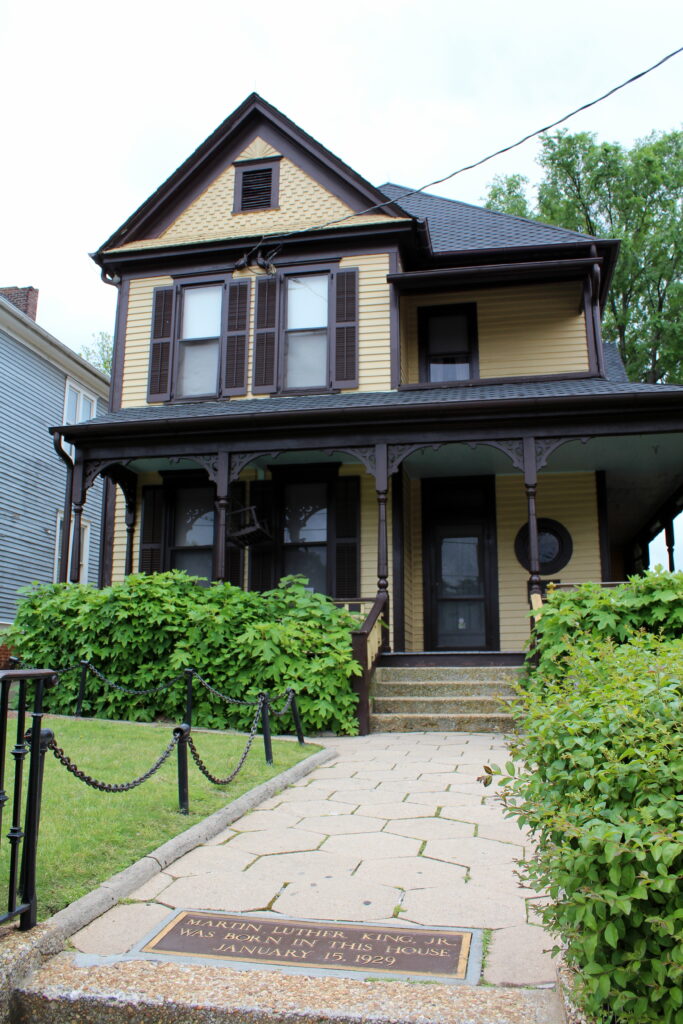
In 1968 Coretta Scott King founded the King Center in Atlanta as a memorial to her husband. The center seeks to advance King’s philosophies of justice and nonviolence through its educational programs, exhibitions, and tours. In 1983 Congress passed legislation to make the third Monday in January a national holiday in honor of King, who remains the only African American to be commemorated in this way. The first Martin Luther King Jr. holiday was observed on January 20, 1986.
Major collections of his papers are owned by Boston University, the King Center, and Morehouse College. In 2000 he was inducted as a charter member into the Georgia Writers Hall of Fame.
King was selected as one of the inaugural honorees for the Extra Mile Points of Light Volunteer Pathway, a monument in Washington, D.C., that celebrates the efforts of national volunteer leaders. The pathway was unveiled in October 2005. In August 2011 a memorial to King was unveiled on the National Mall in Washington, D.C., the first on the Mall to honor either a nonpresident or an African American.


